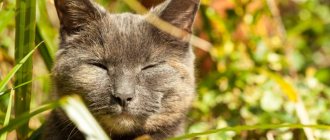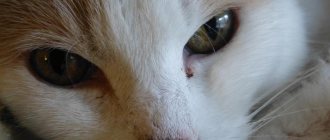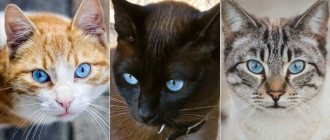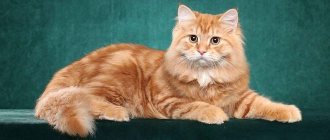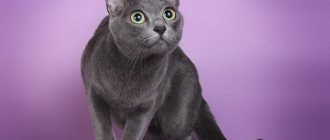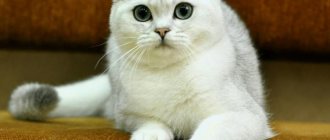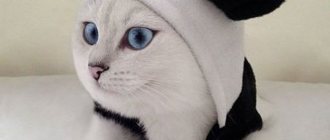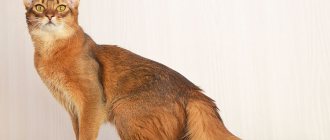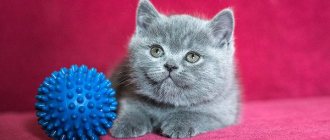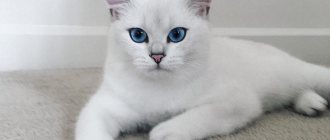The British chinchilla was artificially bred in Great Britain. It got its name from the rodent of the same name because of its similar fluffy and beautiful fur. The color of the breed can be different: from the usual classic silver to gold or smoky. The chinchilla is medium in size and has a well-developed muscular body. She gained her popularity due to her flexible and aristocratic character.
History of the breed
British chinchillas have a rather complicated history of origin; there are several versions. One of them says that cats were brought to England from Ancient Rome. This version is put forward by supporters of the opinion that the British are an ancient breed.
Others claim that cats were bred by English explorers through crossbreeding. The lineage of genetic ancestors made it possible to breed cats with a stable psyche and good health. To get a chinchilla with a beautiful shade and thick fur, breeders crossed Persian cats with smoky British cats.
However, experts were not satisfied with the resulting eye color, which changed from turquoise-green to green with a hint of yellow. This coloring is still found in silver-shaded chinchillas.
To eliminate the imperfection, breeders resumed crossing, periodically infusing Persian blood from Tabby cats. The breed obtained by specialists was formed at the end of the 19th century, but it was only able to receive official confirmation at the end of the 20th century. One of the first British chinchilla cats was Silver Lambkin, introduced in 1880.
To obtain the golden color in chinchilla cats, breeders used the same breeding method as in the case of the first species.
However, the basis for genetic tests was not the Tabby breed, but already bred silver chinchillas. The specialists were faced with the task of preserving the golden color gene in kittens, received from their Persian ancestors.
How to breed this breed
Only experienced breeders who are familiar with all the characteristics of the breed can engage in breeding. Breeding British chinchillas is difficult, since when close relatives are crossed, genetic changes occur that lead to the birth of rejected kittens.
Currently, breeders are working on new colors and improving the quality of the breed. The British chinchilla is still not considered 100% formed.
Choosing a partner
There are very few nurseries for breeding British dogs. Partners are selected carefully, after studying pedigrees. If the offspring will not participate in exhibitions, then the criteria for selecting a partner are less strict. For such mating, you can choose a pet with a slight defect in color.
When choosing a pair, the following criteria are studied:
- strict compliance with the breed standard;
- absence of any diseases;
- animal behavior;
- availability of all documents;
- presence of required vaccinations;
- absence of worms.
If the partner previously had offspring, then their quality should be studied.
First mating
Representatives of the breed are animals whose puberty occurs late. The first mating is allowed no earlier than 20-24 months. Early birth is dangerous for the health of the cat and the life of the offspring.
A British chinchilla can give birth no more than 1-2 times a year. If a cat does not have a break, the quality of the offspring will deteriorate greatly. Frequent childbirth can lead to exhaustion and death of the animal.
Appearance
According to CFA standards, the British chinchilla has smooth and rounded body shapes. The coat is thick with frequent undercoat. The color of short-haired dogs is bright and more pronounced in contrast to the long-haired variety.
There are three types of color:
- silver;
- silver-shaded.
- golden (also called the British golden cat).
Usually the name British chinchillas is applied to cats of a silver-shaded color. According to established standards, the tip of the tail should be colored black only by an eighth part.
Both of the first types on the list are classified as smoky varieties, but depending on the degree of hair coloration they are divided. Silver-shaded cats have darker fur due to the fact that the hairs are dyed black by a third. This is especially noticeable on the paws, tail and ears. In silvers these parts are white.
According to the description, this breed has bright emerald eyes, but green or yellow shades are found in shaded silver ones.
The golden chinchilla is also partially colored. The back, tail and sides are characterized by a blackish veil, and the belly and chest are apricot-colored.
A small photo gallery of chinchillas:
Character of British cats and cats
Reviews about the character of British cats indicate that representatives of this breed are quite calm and aristocratic. The British chinchilla gets along well with all family members, without choosing favorites. Their calm nature allows them to adapt to children. If a cat is angry, it does not attack, but simply leaves the offender.
A cat of this breed has independent character traits. He doesn't like it when people encroach on his freedom or somehow humiliate his cat's dignity. These animals are quite stubborn. According to reviews from owners, if cats don’t want to eat, there is no way to force feed them. Only kindness and cunning can change the situation.
A cat of this breed has independent character traits. He doesn't like it when people encroach on his freedom or somehow humiliate his cat's dignity.
At the genetic level, these cats have an aristocratic character. Based on reviews from owners, we can say that they are accustomed to using a litter tray from early childhood and are quite careful. In the morning they do not wake up the owners, but patiently wait until they wake up.
Common features and habits, differences in appearance
The body structure of the British chinchilla is identical, regardless of color. This breed is characterized by medium size, small paws, and a short tail. At the same time, the body is squat, but powerful. Large and round eyes, pronounced cheeks, dense fur. The head is small with round small ears. The nose is short and wide.
Golden kitten
Characteristic habits
British chinchillas are chosen for their quiet and calm disposition. They are inactive and do not require constant physical activity and games. It is enough to arrange a comfortable place for your pet where he can rest.
However, the breed is attached to its owner, demands attention and shows it. These are affectionate and gentle animals that cannot tolerate long periods of loneliness.
The British chinchilla is suitable for keeping in an apartment, since thanks to the breed's fur, shedding is almost unnoticeable, especially if you brush the cat on time.
Like all cats, British cats are independent, although they love their owner. Despite the desire to be close to humans, they need their own place where they can feel safe; a cat house is suitable for this.
The breed is easy to train and accepts family rules from the first days. It won't be difficult for the owners to accustom him to the tray and scratching post.
The British are not aggressive, so they are often brought into families with children. Irritation is unacceptable for cats; they never hiss or extend their claws. Chinchillas simply leave a place where they are not given rest if they are in a bad mood. Pets quickly find a common language with all the inhabitants of the house. They get along easily with dogs and other cats.
Cohabitation with a furry aristocrat
Cohabitation with a chinchilla cat brings a minimum of hassle. Aristocratic pets are too polite to shit past the tray or trample sleeping owners in the morning. Even kittens, small and eccentric, behave extremely tactfully.
A cat of this breed can be easily accustomed to a daily routine. Murka will happily eat at a specific time of day, knowing and following the routine. However, these cats are stubborn. A bowl of old water may be ignored, and near the leftover food from yesterday's lunch, it will most likely raise its hind paw in displeasure.
The chinchilla cat breed is suitable for people who have a lot of free time. After all, such a pet not only loves high-quality food, but also needs to care for its plush fur coat.
Feeding a British chinchilla
You can feed chinchillas both natural food and prepared food. However, it is worth focusing on brands that contain 30-35% protein. At the same time, you should never mix types of feeding, and the same applies to the type of food.
When choosing a dry diet, the emphasis is on premium and super premium. There are ranges specifically designed for British breeds to suit their needs. Drinking water should always be available in a bowl of food; it is better to give preference to filtered water and change it daily.
If the choice falls on a natural diet, then it should contain the following products:
- raw lean meat (turkey, veal) - before serving, freeze for 12 hours and pour over boiling water to disinfect;
- offal in steamed or boiled form (liver, lungs);
- boiled fish without bones;
- fermented milk products with minimal fat content (sour cream, kefir, cottage cheese);
- unrefined vegetable oil (half a teaspoon per day is enough);
- eggs, preference is given to quail - no more than twice a week;
- vegetables (zucchini, carrots);
- cereal porridge (buckwheat, rice and others).
Some products contribute to changes in coat color and should be reduced in quantity:
- egg yolks;
- red or yellow vegetables and fruits;
- milk;
- butter.
Also read the article on what food you should not give to cats.
The following are deleted from the menu:
- sausages;
- smoked meats;
- raw milk;
- canned food;
- pickles;
- spicy and salty dishes.
The British diet often changes and adapts to the taste preferences of cats, which are quite picky and do not always eat what their owner offers them.
Chinchillas are also prone to overeating, so you should stick to a routine and monitor the amount of food consumed. If this is food, then the portion is measured according to the table indicated on the packaging. Natural food is calculated according to the weight and activity of the animal. Nutrition must be balanced. If this is not dry food, then you need to add vitamin complexes.
Colors of chinchilla cats
All three varieties of chinchillas have very complex color palettes. In general, we can say that animal fur comes in three basic shades:
- silver;
- golden;
- shaded.
Silver individuals are cats with white fur, which has a barely noticeable “spraying” of dark pigment at the very tip of the hair. No spots or extraneous patterns on the body are allowed, but it is imperative that the chest remain white. There are also veil and shaded varieties of silver color. In the first case, a dark “patina” on the wool creates the effect of a veil or organza, slightly darkening the light background of the “fur coat”.
An interesting fact: kittens with a veil color are born only when both parents are carriers of the same color.
Shaded Silver is a completely white undercoat and guard hair, ⅓ of which is dark in tone. The most intense colors of shaded chinchillas are the head, back, ears and tail. The collar area has a classic silver color, and completely dark hairs can appear on the paws and tail.
The palette of chinchilla veil and shading pigments is quite extensive. In particular, the tips of animal hairs can be colored in the following shades:
- chocolate;
- cinnamon;
- faun;
- blue;
- lilac;
- black.
An important nuance: chinchillas in veil-type “fur coats” with black hair pigmentation should have black eye rims bordered by white hair, as well as black paw pads.
The golden color of chinchillas is not identical to the red one. It's more of a soft apricot shade. Individuals with golden veiled “coats” are pets in which the pigment appears only at the very tip of the hair and only in certain areas. The most pigmented parts of the body are the back, ears, head, and tail. On the sides the “veil” noticeably thins and completely disappears closer to the stomach. The shaded golden coat is colored in dark tones for ⅓ of its length. More intensely pigmented areas are the back and head of the animal. The collar area remains white.
Chinchilla care
In order for the British to look good, they require mandatory grooming, which includes several activities.
Combing
Due to their thick coat and dense undercoat, chinchillas require careful brushing. First, combing occurs along the growth of villi, and then in the opposite direction. The procedure should be repeated several times a week, using a comb with special tonic teeth. Such prevention is necessary to prevent the formation of tangles.
Bathing
Chinchillas rarely need baths, otherwise they can dry out the skin and ruin the structure of the coat, making it dull and lifeless.
Bathing should be done once every 4 months. To clean the wool, special pet shampoos and conditioners are used.
Ears
For preventive purposes, ears are inspected for mites 2-3 times a week. If contamination is detected, they are cleaned with special lotions containing silver ions. For the procedure, cotton swabs are used, but not ear swabs. Ear cleaning should be taught from a young age.
Eyes
Due to excessive tearing in the British, eye care is carried out carefully and promptly. All formed clots are immediately removed using a cotton pad soaked in warm water (as an option, you can use chamomile decoction). You can also purchase ready-made eye care products.
You should not self-medicate with purulent discharge and progression of the disease. In order not to harm your pet, you need to contact a veterinary clinic.
Claws
To prevent the cat from damaging furniture and carpeting, its claws should be trimmed 1-2 times a week with special scissors. It is also worth purchasing a scratching post so that the chinchilla can get rid of dead tissue on its own.
Teeth
For prevention, teeth and gums are cleaned weekly with animal toothpaste and a brush. There are convenient finger guards that simplify the procedure.
Toilet
Accustoming a kitten to a litter tray is quite simple, and the filler can be any kind. With age, the British become larger and the toilet must fit in size, so this should be taken care of in advance.
Walk
Walks depend on the nature of the chinchilla. Many of them are ready to go outside, while others are content to stay indoors. You should not put pressure on your pet if he resists and is afraid to leave a safe shelter.
Chinchilla cat standard
Chinchillas are solid and stocky cats. Their image is enhanced by their thick, dense coat, which gives their body a pleasant softness and roundness. Chinchilla cats are noticeably smaller than males, so the latter are always more popular among lovers of textured pets.
The chinchilla color is documented for representatives of three breeds:
- Persian;
- British (short-haired and long-haired);
- Scottish (straight and fold).
Individuals belonging to the Persian clan have longer fur and have super fluffy tails, the hair on which can be twice as long as on the body. The body standard of Persian chinchillas is the same as that of their eastern counterparts, but with minor additions. In particular, the noses of representatives of the first variety are not so short, so the problems of difficulty breathing, characteristic of brachycephalic breeds, are inherent to them to a lesser extent.
British chinchillas are large pets with round heads and chubby cheeks. Their eyes are wide apart, their ears are small with rounded tips, their noses are wide and short. Coat type: semi-long or short. In fact, all representatives of this branch differ from the traditional British only in color. All other characteristics are inherited by pets from their relatives in full. Typically, representatives of this type of chinchilla are silver or golden in color, but the latter option is less common.
Scottish “mix” chinchillas fully fit into the standard of Scottish folds and straights: the same slender legs, muscular body and raised pads on the face. The animals' fur is silver or peach with darkened tips. The hair itself is dense, short, but without a pronounced fit to the body. Acceptable iris colors for Scottish chinchillas are green and blue.
Games, learning and education
Given that this breed prefers a sedentary lifestyle, they still require toys. For physical activity, a cat house is suitable, in which the pet can climb.
In addition, the animal is also given toys: balls, mice, springs. They are suitable for independent play, and to have fun with the owner, buy laser pointers, teasers, and feathers.
Pet stores offer various devices that develop a cat's intelligence and logic.
Training and education
You should start working with a kitten after he has gotten used to the house. First of all, learning begins with mastering the tray; most often, children independently guess the purpose of the toilet.
In the process of education, it is worth focusing on the voice; it should be calm and confident. Aggressiveness during training will not help, given the independence of the animal. In order to ultimately get a balanced cat, you should apply maximum patience and be consistent in your actions.
Silver cat
Before you scold your baby, you need to understand the reasons for his behavior. The best solution would be to contact the breeder. You should not use physical punishment, the kitten will not learn anything, but will begin to be afraid.
Games should take place every day; the British are loving and require attention from the owner. However, you should not allow your kitten to scratch and bite. For games you should use purchased devices.
Relationship with the owner
Cats quickly find a common language with their owner and play with children. The British are prone to apathy. The chinchilla cat loves to be given attention and entertained.
If the owner is busy and cannot pay attention to the golden or silver chinchilla, it becomes offended and begins to get bored. The animal loves to be nearby when the owner is reading a book, watching TV, or doing homework. He will sit in your arms exactly as long as he wants.
The cat is imposing, allows itself to be stroked and scratched behind the ears. But he does not tolerate familiarity. As soon as the owner begins to squeeze the cat or tries to pat it, the pet expresses dissatisfaction. They are the kind of animals that allow themselves to be loved and set their own rules.
Castration
There are several indications for sterilization and castration of chinchillas:
- predisposition to hereditary diseases;
- non-compliance with standards and exclusion from breeding;
- behavior adjustment.
The operation is carried out when the Briton reaches 8-10 months. Before making a decision, you need to consult a veterinarian, he will examine the animal and recommend the optimal time for the procedure.
It is also worth preparing for postoperative care:
- limit your pet's activity;
- ensure peace and quiet;
- do not feed 10 hours before the procedure;
- put on a blanket and collar so that the animal does not introduce infection into the seams by licking itself;
- treat seams with Chlorhexidine.
Advantages and disadvantages of the breed
British pets have many advantages:
- beautiful chinchilla color;
- high intelligence;
- serious, calm, aristocratic character;
- lack of aggression;
- affectionate, friendly attitude towards a person;
- patient attitude towards children;
- unobtrusive behavior.
The breed also has its disadvantages:
- pride, arrogance, independence;
- difficult care;
- a small number of breeders, difficulties in finding a kitten;
- problematic breeding.
Predisposition to diseases
Buying any animal is a responsible step and before doing so you need to familiarize yourself with possible diseases. In the UK, obesity is considered the main problem. This can be corrected through proper nutrition and monitoring of the cat. She should not overeat, the portions are optimal.
When chinchillas gain weight, liver problems begin and diabetes develops. Fat cats have significantly lower life expectancy.
In addition, the British have:
- polycystic kidney disease;
- retinal atrophy;
- hypertrophied cardiomyopathy.
Choosing a kitten and its cost
Many owners prefer British chinchillas for their sophistication, grace and beauty. A calm disposition and affection also play a decisive role. This breed is intelligent and gets along well with children and other animals.
Before buying, you need to familiarize yourself with the kitten’s pedigree so as not to stumble upon unscrupulous sellers. The price varies from 20,000 to 50,000 rubles depending on gender, color and availability of documents. You should take home a kitten at three months of age only from a trusted nursery and after signing an agreement.
Kittens
British breed babies do not have clearly defined coat and eye colors. In childhood, the fur of a golden chinchilla cat can be distinguished. The animal is finally formed by the age of 1.5 years. In an adult animal, the color of the fur and eyes is visible, and it no longer changes with age.
For kittens to develop normally, food must be age appropriate. It is better to use ready-made dry and wet food. Kittens should not be fed cow's milk. For them, it is better to use goat’s milk or diluted in a ratio of 1:3 (where 3 parts are cow’s milk).
Pros and cons of purchasing
To decide whether it is worth getting a British chinchilla, you need to compare its advantages and disadvantages.
| pros | Minuses |
| A great companion. | Independent. |
| Easy to learn. | Sometimes proud and stubborn. |
| Good health. | There are some nasty ones. |
| Unusual and beautiful appearance. | They prefer to choose one owner. |
| High intelligence. | Avoid unpleasant company. |
| Loyalty and affection for the owner. | Requires regular care. |
| Gentle and affectionate pets. | Sometimes they suffer from obesity. |
| Non-aggressive. | Tearing. |
| They practically do not shed. |
Health
British chinchillas are distinguished by good health. These are hardy animals that are not afraid of frost and wind. Warm and thick wool reliably protects pets from the vagaries of the weather. But it’s better not to take your fluffy for a walk in the rain or slush.
Like all cats, chinchillas suffer from kidney disease. Bring your pet to the veterinarian periodically to detect pathology at an early stage.
The British have watery eyes, and this is taken into account when purchasing a kitten, since the eyes will require care.
